Knowledge from A-Z
Special terms relating to window technology

Accessibility
Barrier-free construction is extensive and should ideally be planned from the start. For example, passageways must be appropriately wide, high and passable without tripping hazards. Buttons, handles or similar items must be within easy reach. There are also many other requirements. The exact standards for barrier-free construction are summarized in DIN-18025.
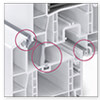
Seals (all-round)
On the one hand, seals ensure that warm air from the interior cannot flow to the outside. On the other hand, they prevent the penetration of moisture and drafts.
REHAU profile systems with a center seal have a special sealing concept and contain three circumferential sealing levels. At the same time, this ensures optimized closing pressure, which significantly reduces the effort required to open and close the window.

Burglary resistance
Burglary prevention measures are intended to make unauthorized entry into the house or apartment more difficult. This is achieved for windows by using special locking cylinders, protective fittings and glazing.
Which resistance class RC (resistance class) makes sense for which window depends primarily on the installation location (ground floor, upper floors, etc.). The classification of the resistance classes RC is regulated in the test standard DIN V ENV 1627 for windows and doors and depends on the type of break-in attempt. The window specialist will advise you in detail on this.
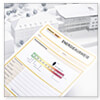
Energy certificate
The energy certificate is a document that evaluates buildings from an energy perspective. Potential buyers and new tenants are generally entitled to view the energy certificates. Owners of large, busy public service buildings must display an energy certificate.
Those eligible to exhibit include architects, planners, master craftsmen and state-recognized technicians, provided they have acquired the relevant knowledge during their training or have completed appropriate further training.
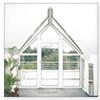
Energy efficiency, energy saving, thermal insulation
Energy consumption can be reduced through the efficient use of energy and the reduction of energy losses through thermal insulation. This helps to conserve resources, reduce CO2 2 emissions and save money. The more energy efficient a window is, the less energy is used and the lower the costs.
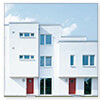
Energy Saving Ordinance (EnEV)
The Energy Saving Ordinance is an essential element of the federal government’s energy saving and climate protection policy. The regulation serves to increase energy savings in buildings and thus also reduce the impact on the environment.
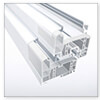
Fiber composite material RAU-FIPRO X
RAU-FIPRO X is a self-developed, fiber-bonded high-tech material. Fiber composite materials consist of two main components: the base material and the reinforced fiber material. The mutual interaction of the two substances significantly improves the overall properties. Fiber composite materials have already proven themselves under the most extreme conditions, for example in Formula 1 and in aircraft construction. Thanks to RAU-FIPRO, this successful technology was used for the first time in a window system in 2008. The patented profile core made of RAU-FIPRO X gives the GENEO window maximum stability. This eliminates the need for steel reinforcement in up to 90% of applications and therefore enables the highest level of thermal insulation without compromise. The high-tech material is completely recyclable. This is particularly important in terms of responsible use of resources and the environment.99
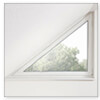
Window shape
In addition to the color of the window and the division by bars, the shape of the window also shapes the overall appearance of a house. GENEO offers the best conditions for formability. For example, slanted, triangular, trapezoidal or arched windows can be easily created.
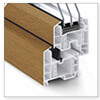
Foil lamination
The surface of GENEO can be coated with a colored film using a special process. You can choose from more than 40 laminating films in grained or smooth versions.
The coating does not affect the quality, but only has a design effect. The colored profiles are then just as weather-resistant and easy to clean as windows without a laminated surface.
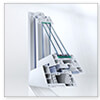
Window profile
The window frame is made from the window profile. As a rule, a distinction is made between sash (can be opened) and frame (is anchored in the house wall). There are many different types of profiles in terms of construction depth, number of integrated chambers and view width. The quality and design of the window profile, in addition to the window glass, has a decisive influence on the properties and overall quality of the window. The better a window profile, the more efficient the window is in terms of thermal insulation, sound insulation or burglary resistance.
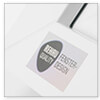
HDF surface
Like all window systems from REHAU, GENEO also has the unique HDF surface (High Definition Finishing). This special surface gives an elegant, brilliant shine, is smooth, closed and therefore very easy to care for and weather-resistant.

Plastic windows
Plastic windows are windows whose frames are made of PVC or – as with GENEO – made of a fiber-reinforced plastic.
Plastic windows are characterized by a very good price-performance ratio and are extremely popular due to the very low care and maintenance required, as well as the diverse design options in terms of shape and color.
REHAU plastic windows are completely recyclable.
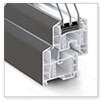
Painting
In addition to foil lamination, the GENEO surface can also be painted for color design. There are more than 170 RAL colors to choose from.
The coloring does not affect the quality, but only has a design effect. Proven techniques from the automotive industry are used to carry it out.

Ventilation
Modern windows close very tightly. Due to this tightness, regular ventilation is very important for a pleasant indoor climate: – Room air humidity and temperature are regulated – Used air is replaced with unused fresh air – Condensation and mold formation are avoided.
Even the Energy Saving Ordinance (see above) addresses this topic. The primary energy requirement for heating, hot water preparation, ventilation and cooling permitted by the regulation is determined using a reference building.
It is precisely this reference building that provides for an exhaust air system. Such a system supplies and exhausts outside air. This control ensures that living spaces are optimally ventilated, thereby reducing energy losses and saving heating costs.
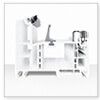
Air chambers (insulating)
GENEO windows (for example) have six insulating air chambers or functional chambers in the profile. These air chambers have a significant influence on the insulating performance of the profile.
In addition, a special thermal module can be installed in the largest of these chambers. With this measure, GENEO windows can be manufactured that meet passive house standards.
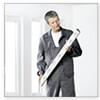
Assembly
Just as important as the quality of the window is professional installation. The work must be carried out conscientiously and in compliance with all building regulations.
We provide our specialist companies with detailed documents, offer regular training courses on assembly and other important topics from the industry through our REHAU AKADEMIE and also keep them up to date with regard to legal regulations.

Passive house
A passive house has optimized thermal insulation and therefore does not require a heating system. The requirements for a passive house window are very high and complex. For this reason, the systems used must be passive house certified.
GENEO is officially certified by the Passive House Institute Darmstadt.
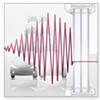
Soundproofing
The sound insulation of a window is defined by the insulation values of the profile and the glazing.
In order to determine uniform parameters for the sound insulation value of a window, there are five sound insulation classes (SSK) in Germany.
For example, if the living space is near a motorway, the highest sound insulation class – SSK 5 – is recommended.

Tightness from driving rain
The driving rain tightness describes the resistance of a window to the ingress of water caused by rain and wind.
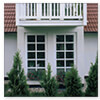
Sprouts
You can emphasize the individuality of your windows with window bars. Bars divide your windows into smaller sections and give the facade a personal touch. You can choose between muntins in the space between the panes, attached muntins and glass dividing muntins.
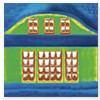
U-value
The U-value is the heat transfer coefficient. It is used to evaluate the thermal insulation of a window and indicates the amount of energy that flows through an area of 1 m² in one hour. The lower this value is, the higher the thermal insulation. There are three different U-values for windows:
- U f = frame
- U g = glass
- U w = window
The overall insulation of a window (= U w ) results from the two coefficients U f and U g as well as the heat loss of the edge composite used for the insulating glass pane (aluminum, stainless steel, polymer/plastic).
The smaller the U-value, the better the thermal insulation.
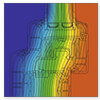
Thermal bridge, heat conductor
Heat is quickly transported to the outside through heat conductors (also called thermal bridges). Steel – which is used in conventional plastic windows for stability – is a heat conductor. Because of it, precious energy is lost.

